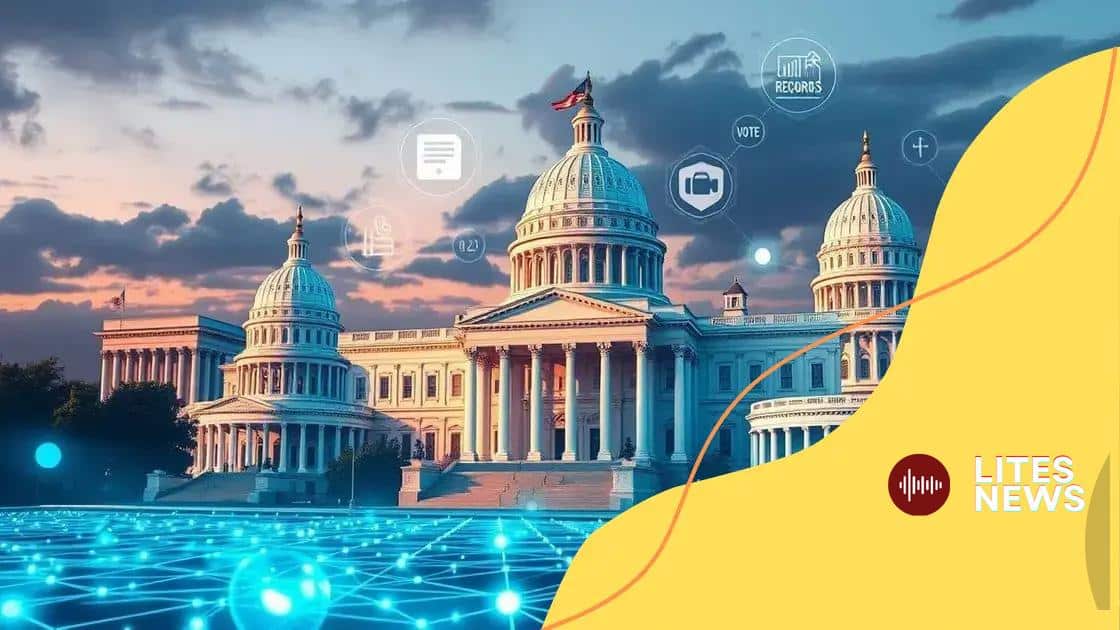Blockchain applications in government transparency

Blockchain applications in government transparency enhance accountability and trust by providing secure, immutable records, improving public access to essential data and streamlining processes across various sectors.
Blockchain applications in government transparency are making waves in how we view accountability and trust in public sectors. Have you ever wondered how technology can reshape governance? Let’s dive into the transformative power of blockchain.
Understanding blockchain technology
Understanding blockchain technology is essential in today’s digital world. At its core, blockchain is a system that allows multiple parties to share and secure information without needing a centralized authority.
This technology works like a digital ledger, recording transactions across many computers so that the recorded transactions cannot be altered retroactively. This makes it highly secure and transparent. However, many people still wonder how it really works and what it can do.
Key Features of Blockchain
There are several important characteristics of blockchain technology that make it beneficial. These include:
- Decentralization: Unlike traditional databases, blockchain is not stored in a single location, which reduces risks.
- Immutability: Once information is added to the blockchain, it cannot be changed, ensuring data integrity.
- Transparency: All transactions are visible to everyone on the network, which promotes trust.
- Security: Advanced cryptography protects data from unauthorized access.
These features revolutionize various industries, including finance and supply chain. For instance, in finance, blockchain can streamline payments, making them faster and cheaper. In supply chains, it can track goods from production to delivery, ensuring accountability.
How Blockchain Works
When a transaction occurs, it creates a block containing details such as timestamps and transaction data. This block is then verified by other users in the network. Once verified, it gets added to the end of the chain of blocks, forming a blockchain.
This process involves consensus algorithms to reach an agreement among users about the validity of a transaction. Popular methods include Proof of Work and Proof of Stake. Both methods help maintain security and integrity.
In conclusion, understanding blockchain technology opens the door to various applications that can change the way we interact, conduct business, and ensure transparency. As we continue to explore its potential, it is clear that it plays a crucial role in shaping the future.
Benefits of blockchain for transparency
The benefits of blockchain for transparency are substantial and transformative. This technology enhances the reliability of data and builds trust among users. As traditional systems often have hidden processes, blockchain provides a clear and open way to manage transactions.
One of the most significant advantages of blockchain is its ability to create a permanent, unalterable record. This feature means that once information is entered into the blockchain, it cannot be changed, ensuring the accuracy and integrity of data.
Key Advantages of Blockchain Transparency
There are several key advantages that blockchain brings to transparency:
- Increased Accountability: By making transactions visible to all participants, everyone is held accountable for their actions.
- Reduced Fraud: The secure nature of blockchain helps prevent fraudulent activities. Since records cannot be altered, it significantly diminishes the risks associated with tampering.
- Enhanced Trust: Transparency fosters greater trust among stakeholders. When information is accessible, it builds confidence in processes.
- Streamlined Processes: By reducing the need for intermediaries, blockchain simplifies many operations, making them faster and more efficient.
Moreover, public services can significantly benefit from this technology. For instance, in public sector operations, you can trace how funds are used, ensuring that taxpayer money is spent properly.
This is vital for governance, where public trust is essential. When citizens can see how decisions are made and how funds are allocated, it reinforces democracy and accountability.
Real-World Applications
Many organizations are already harnessing blockchain’s benefits. In the supply chain industry, companies are using it to track product journeys, ensuring that consumers know where their products come from.
This kind of transparency can help in many industries, from healthcare, where patient records can be secured, to finance, where transactions can be quickly verified. As this technology continues to develop, its applications are expected to grow.
Real-world examples of blockchain in government

Real-world examples of blockchain in government illustrate how this technology can enhance transparency and efficiency. Governments around the world are starting to adopt blockchain to improve public services and accountability.
One notable example is the use of blockchain in voting systems. Some countries, like Estonia, have implemented blockchain to secure their elections. This method allows citizens to vote online safely while ensuring that votes are accurately counted. Such systems reduce the risk of fraud and increase public trust in the electoral process.
Blockchain for Public Records
Another area where blockchain is making a significant impact is in the management of public records. In countries like Georgia, officials use blockchain technology to keep land ownership records. This system helps prevent disputes over property ownership and provides a secure, transparent way to track land transactions.
- Secure Land Registries: Blockchain helps maintain accurate and tamper-proof land titles.
- Improved Access: Citizens can easily access their land records, reducing bureaucratic delays.
- Reduced Corruption: Transparent records minimize opportunities for fraudulent practices.
In addition, several U.S. states are experimenting with using blockchain for tracking government contracts and funds. These implementations help ensure that taxpayer money is used efficiently and responsibly.
Blockchain is also being tested for civic registration purposes. In countries like the Philippines, officials are exploring how blockchain can streamline the process of registering births and marriages. This initiative aims to create a more organized and reliable system for maintaining vital records.
Challenges and Considerations
While there are many benefits, the adoption of blockchain in government faces challenges. Questions around privacy, security, and the initial costs of setup remain crucial concerns. Ensuring that all citizens can access and understand these systems is also essential for effective implementation.
Despite these challenges, the push for integrating blockchain in government shows promising potential. As more governments test practical applications, they pave the way for a more transparent and efficient future in public services.
Challenges of implementing blockchain
Implementing blockchain technology comes with various challenges that organizations and governments must address. While this technology offers significant benefits, the path to integrating it can be complex and requires careful planning.
One of the primary challenges is the need for proper infrastructure. Blockchain requires robust hardware and software systems to function effectively. This can involve high initial costs, especially for smaller organizations without the necessary resources.
Regulatory and Legal Issues
Another significant challenge involves regulatory and legal issues. Governments around the world are still figuring out how to classify and regulate blockchain technology. There are concerns about ensuring compliance with data protection laws and financial regulations.
- Data Privacy: Ensuring compliance with laws like GDPR can be difficult, as blockchain records are often public.
- Liability Issues: Determining who is responsible for mistakes or breaches on a blockchain can complicate legal frameworks.
- Cross-Border Regulations: Different countries have various regulations that can create confusion for international transactions.
Moreover, there is a significant knowledge gap regarding blockchain technology in various sectors. Many stakeholders may not understand how it works or what it entails. This lack of understanding can lead to resistance to change and slow down adoption.
Interoperability and Scalability
Interoperability among blockchain systems is another hurdle. Different blockchains often operate in silos, making it hard to share data across platforms. Organizations need to find solutions that allow different blockchains to work together.
Additionally, scalability remains a key concern. As more users join a blockchain network, the system may face latency issues. Finding ways to scale effectively without compromising performance is crucial.
Lastly, cybersecurity threats loom large. Although blockchain is considered secure, it is not invulnerable. Threats like hacking can still target applications built on blockchain, creating potential risks for users and organizations.
Future of blockchain in public sector
The future of blockchain in the public sector holds great promise as governments explore innovative ways to harness this technology. As more entities recognize its potential, we can expect to see significant growth in its applications.
One key area for future development is enhancing transparency and accountability in governmental processes. As blockchain allows for secure and immutable records, public officials may increasingly use it to ensure that transactions are clear and accessible to citizens.
Potential Applications
There are several exciting possibilities for blockchain’s role in the public sector:
- Digital Identity Verification: Blockchain can provide citizens with secure digital identities, reducing identity fraud and simplifying access to services.
- Streamlined Procurement Processes: Governments can utilize blockchain to track public contracts transparently, helping reduce corruption and waste.
- Efficient Welfare Distribution: By managing social benefits on the blockchain, payments can be made directly to eligible recipients, ensuring funds reach those in need.
- Environmental Monitoring: Blockchain can enhance data sharing in environmental efforts, allowing for better tracking of resources like water or energy use.
As governments work on pilot projects and test implementations, they also face the challenge of ensuring technological adoption among staff and citizens. Education and clear communication will be vital to overcome resistance and promote understanding.
Collaboration and Integration
Collaboration between governments, private sector companies, and research institutions will be essential to develop successful blockchain solutions. Partnerships can facilitate knowledge sharing and accelerate the implementation of effective systems.
Integration with existing technologies will also be important. As governments seek to implement blockchain, they will need to ensure that it works seamlessly with current platforms and infrastructure.
In conclusion, the future of blockchain in the public sector is poised for growth and innovation. By addressing challenges and focusing on collaborative efforts, blockchain can significantly enhance transparency, efficiency, and trust within public services.
FAQ – Frequently Asked Questions about Blockchain in the Public Sector
How can blockchain increase transparency in government?
Blockchain provides a secure and accessible way to record transactions, making public processes more visible and accountable.
What are some real-world applications of blockchain in government?
Blockchain can be used in voting systems, public records management, and social welfare distribution, enhancing efficiency and trust.
What challenges do governments face when implementing blockchain?
Key challenges include regulatory issues, infrastructure costs, and ensuring stakeholder understanding and acceptance of the technology.
What does the future hold for blockchain in the public sector?
The future looks promising as more governments explore its benefits, with potential for enhanced services and greater collaboration.





